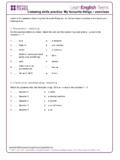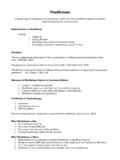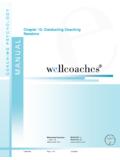Transcription of COMPLETE FOCUSING INSTRUCTIONS
1 1 COMPLETE FOCUSING INSTRUCTIONS A. PRE- FOCUSING PRACTICE: 1. Relaxation Exercises 2. Getting A Felt Sense B. COMPLETE FOCUSING SESSIONS 1. How Am I Today? 2. Clearing A Space 3. Remembering A Situation Disclaimer: COMPLETE FOCUSING INSTRUCTIONS are offered purely as self-help skills. In providing them, Dr. McGuire is not engaged in rendering psychological, financial, legal, or other professional services.
2 If expert assistance or counseling is needed, the services of a competent professional should be sought. Kathleen McGuire, , 2007 Creative Edge FOCUSING 2 INTRODUCTION From Intuitions to Ahah!s : A Predictable Method FOCUSING is a naturally-occurring, internal, problem solving process. It happens when an individual stops to ponder at the felt edge of what is known, the sense that there is something-that-is-more-than-words. Research on success in psychotherapy showed that the clients who changed most in therapy were those who were naturally stopping to ponder upon this unclear, felt, intuitive sensing of where they were stuck or how they could heal.
3 Research on creativity found the same thing. The most creative people were those who naturally stopped to ponder at this intuitive edge of what they already knew. They would go back-and-forth between this unclear intuitive feel and words or images until they found symbols that were exactly right in capturing the feel of this intuitive edge of consciousness. Dr. Eugene Gendlin of the University of Chicago and The FOCUSING Institute ( ) called this intuitive edge of consciousness the felt sense. He decided it was important to teach this skill of pondering at the intuitive edge to everyday people, to use for personal growth and creative problem solving.
4 In his self-help book called FOCUSING (Bantam, 1981), Gendlin broke this process of pondering down into six steps and called it FOCUSING . He described FOCUSING upon the felt sense, and going back-and-forth between symbols (words and images) and the felt sense until the exactly right symbols are found to capture the felt sense. At that moment, the Focuser experiences a felt shift, a conscious experience of Oh, that is exactly right. It s this! The solutions to problems are already present in the body as the right-brained information which comes as an intuition or a hunch.
5 Anyone could now use FOCUSING to sit with the intuitive edge of consciousness and to create new behaviors and new ideas out of this intuitive feel. Gendlin received the award for Distinguished Professional Psychologist from the American Psychological Association in 1970 for his work with FOCUSING and experiential therapy. His FOCUSING book has been translated into over fifteen languages, and there is an international network of FOCUSING teachers, and millions of trained Focusers, spread throughout the world ( ). Interest in Malcolm Gladwell s best seller, Blink: The Power of Thinking Without Thinking (Little, Brown, 2005) indicates that everyone is ready to recognize intuitions and hunches as valuable routes to decision making.
6 Gladwell stated that intuitive information was from the subconscious and could not easily be unpacked and made consciously known. But Gendlin s FOCUSING , which has been thoroughly researched for over thirty years, is a predictable method for 3 taking intuitions and hunches and turning them into verbalized, consciously-known Ahah! experiences Dr. McGuire of Creative Edge FOCUSING calls the felt sense the intuitive feel, since it is like that internal sensing that we refer to as an intuition, a hunch. She also calls this intuitive edge of consciousness The Creative Edge, because it is in this intuitive feel, this right-brain information, that creative ideas and innovative solutions to problems can be found.
7 She calls the felt shift a Paradigm Shift, emphasizing that, when symbols are found for the intuitive feel, the light bulb goes on, the kaleidoscope turns, the Gestalt changes, and brand new behaviors, emotions, and ideas suddenly pop up and become possible, Instant Ahah! s. If you haven t yet, you can subscribe to the Instant Ahah! s newsletter at to receive a weekly reminder to pause and ponder at The Creative Edge and to download a free manual with ten Instant Ahah! methods you can try, immediately, at home and at work. Learning FOCUSING : Sitting at the Creative Edge of Consciousness We all know there are times when we are aware of, and are guided by, a kind of gut feeling or intuition.
8 An intuition is without words, but very concretely present inside, as a feeling-without-words. If I asked you where in your body you experience intuitions or hunches, what would you say? They are not really a thought or image in your head, but more of an experience that you have in your body. We say I have a gut feeling about or Something in my heart tells me I have to do Certainly, we think of intuitions as going with our heart, not our head as right-brain rather than left-brain decision making. Many people experience the felt sense or intuitive hunch as a gathering of energy in the stomach or in the chest/heart area not the bones or muscles but a gathering of energy or subtle sensing in that area.
9 Gendlin s FOCUSING , which Dr. McGuire calls Intuitive FOCUSING , is a method for paying attention to this intuitive feel, this gut sensing, and carefully looking for words or images that are exactly right in describing it. When the right symbols are found, the felt sense opens and changes, with new solutions and action steps arising. In order to teach you how to use FOCUSING for personal, spiritual, and creative problem solving, the following exercises break the Intuitive FOCUSING process down into parts and teach the parts in sections. Then, at the end, you will be walked through some COMPLETE FOCUSING INSTRUCTIONS .
10 If you want to try out COMPLETE FOCUSING right away, skip to Having A Paradigm Shift: COMPLETE FOCUSING INSTRUCTIONS . Or you can use the exercises in the Instant Ahah! s Mini Manual available at . But you will be asking yourself to plunge right into 20-30 minutes of inner attention, meditation-like inward action steps. If you have little experience in spending quiet, pleasant, meditative time, you will find the Relaxation exercises below an invaluable, pleasant, stress-reducing first step into quiet time inside. 4 Many people also learn Intuitive FOCUSING most easily in the company of a Focused Listener.






